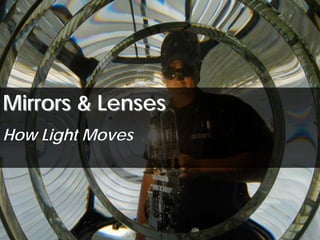
Mirror and lens notes
- 1. Mirrors & Lenses How Light Moves
- 2. Review When light strikes an object, 3 things can happen. The light can be: Reflected Transmitted Absorbed
- 3. Reflection Off A Plane Mirror Light reflects off a plane (flat) mirror in a certain way. Incident Ray Normal Reflected Ray Angle of Angle of incidence reflection Plane Mirror
- 4. The Law of Reflection The Law of Reflection states that for a plane mirror: Angle of Incidence = Angle of Reflection Incident Ray Normal Reflected Ray Angle of Angle of incidence incidence Plane Mirror
- 5. Images In A Plane Mirror Light rays reflect off a plane mirror in a regular way. Angle of the light = Angle to come from This makesIncidence rays seemof Reflection behind the mirror at an equal distance.. This forms an image that is upright and the same size. It is a virtual image, since the light is not actually coming from the image.
- 6. Forming A Virtual Image Virtual Image Upright Same Size Reversed
- 7. Concave Mirrors Concave mirrors have surfaces that curve inward. A concave mirror reflects light rays so that they converge (meet) at a certain point. We call this point the focal point of the mirror.
- 8. Concave Mirrors Concave mirrors form images in 2 different ways. The type of image depends on the distance the object is placed from the focal point. Focal Point
- 9. 1. Object is placed behind the focal point. Real Image Upside down Smaller 2. Object is placed in front of the focal point. Virtual Image Upright Larger
- 10. Convex Mirrors Convex mirrors have surfaces that curves outward. A convex mirror reflects light rays so that they diverge (spread out). The light rays do NOT meet at a focal point in front of the mirror.
- 11. Convex Mirrors Convex mirrors ALWAYS form images the same way. A convex mirror forms a virtual image that is smaller than the true object. Focal Point
- 12. Refraction Refraction is when light rays are bent. When light rays pass from one material to another, the light rays refract (bend). The rays change direction where the 2 materials meet. The light bends because it changes speed in different materials (mediums).
- 13. Refraction Medium 1 - Air Light travels fast Medium 1 - Water Light travels slow
- 14. Index of Refraction Some mediums refract light rays more than others. This is described by the index of refraction.
- 15. Index of Refraction Some mediums refract light rays more than others. This is described by the index of refraction.
- 16. Index of Refraction Some mediums refract light rays more than others. This is described by the index of refraction.
- 17. Index of Refraction Indexes of Refraction for Common Materials Vacuum 1.00 Air 1.01 Water 1.33 Glycerine 1.47 Glass 1.52 Diamond 2.42
- 18. Lenses A lens is a curved device that refracts light precisely. Lenses are useful because they can refract light rays in a predictable way. There are 2 types of lenses: Concave Convex
- 19. Concave Lens A concave lens is thinner in the middle. A concave lens bends parallel light rays to make them diverge. Produce a virtual image only
- 20. Convex Lens A convex lens is thicker in the middle. A convex lens bends parallel light rays so that they meet at a focal point. Produce a real or a virtual image
- 21. Lenses Lenses have many uses.
- 22. Any Questions?